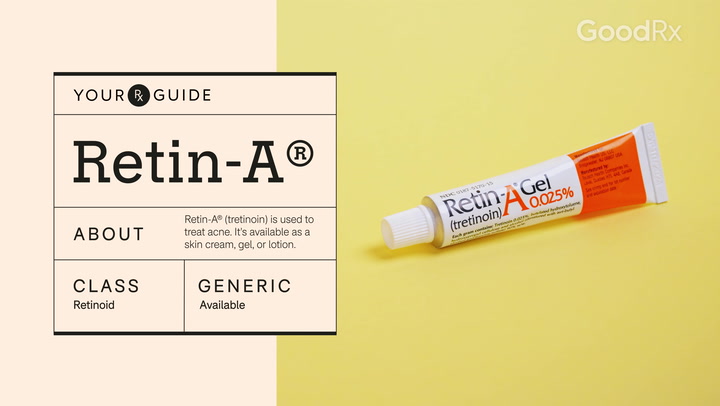
How Much Does Retin-A Cost Without Insurance?
Key takeaways:
Retin-A, a brand name for tretinoin, is a topical medication often used to treat acne. It may also be used off-label to reduce wrinkles by promoting skin cell turnover.
The average retail price for a tube of Retin-A cream ranges from $40 to $115, depending on the pharmacy you choose, your location, and other factors. You can typically find the Retin-A gel for $59 to $100.
There are several ways to save on Retin-A. GoodRx can help you access brand-name Retin-A at an exclusive cash price as low as $39.04.
Access savings on related medications

Retin-A (tretinoin) is a topical medication often used to treat acne and reduce wrinkles. Although people aged 12 to 24 are more likely to experience some form of acne, adult acne can continue in your 30s, 40s, and even 50s. Research shows that an estimated 50 million Americans deal with acne each year, making it one of the most common skin conditions in the U.S.
The price of Retin-A can vary depending on many factors, including prescription strength, the pharmacy you choose, and insurance coverage. Whether you have insurance or not, you can save money on the cost of Retin-A with a GoodRx coupon.
How much is Retin-A, and what affects the price?
Retin-A is the brand name of the medication known as tretinoin. Retin-A’s cost can be affected by several factors, which can lead to significant price variations across different pharmacies and locations.
Currently, the retail price of Retin-A without insurance ranges from $40 to $115 for a 45 g tube, depending on the strength you are prescribed. You can typically find the Retin-A gel for $59 to $100. Without insurance, the retail price of generic tretinoin ranges from $100 to $300.
Your out-of-pocket cost for Retin-A may depend on factors such as:
Location: The price of Retin-A can vary from city to city. According to GoodRx research, prescription medications typically cost more in Los Angeles than in Houston, for example.
Pharmacy: Larger pharmacy chains can negotiate lower prices for Retin-A with medication manufacturers. Online pharmacies and mail-order options may also provide competitive pricing and convenience.
Discounts: Prescription savings coupons like GoodRx or programs offered by Retin-A’s manufacturer may lower costs.
Insurance: With insurance, you generally pay a copayment or coinsurance amount for Retin-A. The price varies based on your plan's formulary. Formularies place medications into tiers, with lower tiers usually having lower out-of-pocket costs.
Quantity: You may get reduced costs if you buy Retin-A in larger quantities. But if your medication is covered by insurance, there may be restrictions on the amount of medication you can fill at one time. There may also be different copayment structures for larger quantities.
Dosage: Retin-A dosages may be priced differently. Your healthcare professional may start with a low strength until your skin gets used to the medication, then increase the dosage. Insurance copayments or coinsurance amounts may also differ based on your prescribed dosage.
Does insurance cover Retin-A?
Whether your insurance provider covers Retin-A depends on the details of your plan. You may find your plan only covers the medication for non-cosmetic conditions. Review your plan for coverage limitations and out-of-pocket costs.
Private and employer-sponsored health insurance
If Retin-A is covered by your insurance but listed as a non-preferred medication, you may have to try a preferred medication — like generic tretinoin — first. For example, Cigna requires you to try the tretinoin cream or gel before you can get coverage for Retin-A. If the formulation difference in the medication causes a severe adverse reaction or significant allergy, you may be able to get your insurance to cover Retin-A.
You may also need prior authorization for insurance to cover Retin-A if you’re over a certain age. For example, Blue Cross and Blue Shield of Minnesota and Blue Plus (Blue Cross) require prior authorization for topical retinoids if you’re 30 years of age and older.
If your insurance plan does cover Retin-A, you may also need to meet certain requirements such as having a non-cosmetic condition. Non-cosmetic conditions include acne vulgaris, rosacea, and precancerous skin lesions. If you have a cosmetic condition, such as liver spots, stretch marks, or wrinkles, you may not be able to get coverage.
Medicare
Check your Medicare Part D medication plan formulary to see if it covers Retin-A. All these plans must cover at least two medications in the most commonly prescribed categories and classes. However, insurance providers can choose which medications to cover. If your healthcare professional believes the covered medications won't work, you can ask your insurance provider for an exception.
Medicaid
Federal law doesn’t mandate that state Medicaid programs provide prescription medication coverage. However, all states currently offer this coverage as a benefit to those who are eligible.
The Medicaid Drug Rebate Program (MDRP) allows states to exclude coverage for medications used for cosmetic purposes. So coverage may depend on the prescription’s use. Check your state’s formulary for details.
How to get Retin-A covered by insurance
Here are ways to increase the chance of your insurance covering Retin-A.
Review your insurance plan. Look at your formulary and other documents such as the prescription medication coverage section and summary of benefits and coverage.
Talk with your prescriber. Your prescriber can verify whether your insurance covers Retin-A. If not, they can explain to your insurance company why the medication is medically necessary or suggest alternatives.
Get a prescription for Retin-A. Schedule an appointment with your prescriber to learn about the benefits and side effects of this medication and the possibility of getting a prescription.
Secure prior authorization. Your insurance provider may want prior authorization before covering tretinoin. Your prescriber may need to explain why it's preferable to alternatives.
Find out if step therapy is necessary. Step therapy involves your insurance company mandating specific actions you must take before it will cover your medication. You may have to try a preferred medication first if tretinoin is non-preferred.
Request an appeal. If tretinoin isn't covered, talk to your prescriber about filing an appeal. This process generally involves writing a letter to your insurance provider. Detail your health condition, medication necessity, and why you believe the medication should be covered.
Ways to save on Retin-A
Here are six ways to save money on tretinoin — whether you have insurance or not.
1. Use a free GoodRx coupon
GoodRx has free coupons for various medications, including Retin-A. Download the GoodRx app or log on to goodrx.com.
Anyone with a valid prescription, regardless of insurance status, can use GoodRx to purchase brand-name Retin-A cream for as little as $39.04 for a 45 gram tube. GoodRx also offers exclusive savings on Retin-A gel, with prices as low as $39.04 for a 45 gram tube.
2. Compare pharmacy prices
While on the GoodRx app or website, you’ll notice how the prices for tretinoin vary among pharmacies. See how much the costs differ and decide if switching your prescription to a new pharmacy is worth it.
3. Compare generic vs. brand prices
Brand-name medication prices are usually much higher than generic medication costs. This discrepancy is why insurance plans often prefer generics over brand-name drugs. Currently, Retin-A may cost less than generic tretinoin. You may want to discuss this situation with your insurance provider.
4. Look into patient assistance programs
Bausch Health, the manufacturer of Retin-A, has a patient assistance program. This program may cover the full cost of Retin-A or provide a discount if your health insurance doesn’t cover the medication. To find out if you can apply, visit the Bausch Health Patient Assistance Program website.
5. Consider alternative medications
Other topical acne treatments may cost less than tretinoin. They also may be covered by your insurance. Clindamycin (Cleocin-T) and erythromycin are prescription-strength topical medications. Benzoyl peroxide and Differin gel (adapalene) are over-the-counter (OTC) medications.
6. Buy a 90-day supply
The quantity of prescription medications like tretinoin can impact costs. Generally, pharmacies offer lower unit prices for medications when you purchase them in large quantities. Look into a 90-day supply instead of a 30-day supply.
The bottom line
You may have to pay between $40 to $115 without insurance for Retin A. The cost depends on factors such as the strength and pharmacy you choose as well as your location. Currently, Retin-A may cost less than generic tretinoin. Whether you have insurance may also affect your out-of-pocket costs for Retin A. Without insurance, you may be eligible for patient assistance. Save money on Retin-A by using a GoodRx coupon and looking at different pharmacy prices.
Why trust our experts?



References
American Academy of Dermatology Association. (n.d.). Adult acne.
American Academy of Dermatology Association. (n.d.). Skin conditions by the numbers.
BlueCross BlueShield Minnesota. (2017). New drug-related prior authorization criteria: Topical retinoids.
Cigna. (2023). Cigna national formulary coverage policy: PA topical retinoid – Tretinoin products.
Cigna. (2023). Drug and biologic coverage policy: Topical tretinoin products.
GovInfo. (2021). 42 U.S.C. 1396r-8: Payment for covered outpatient drugs.
Medicaid.gov. (2024). Medicaid Drug Rebate Program (MDRP).
Medicaid.gov. (n.d.). Prescription drugs.
Medicare.gov. (n.d.). What Medicare Part D drug plans cover.
Was this page helpful?
Related Articles
Browse medications
View AllResearch prescriptions and over-the-counter medications from A to Z, compare drug prices, and start saving.



























